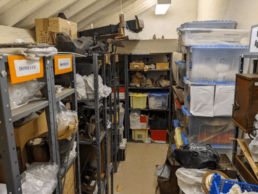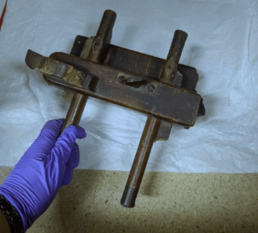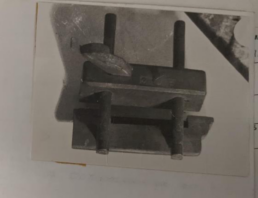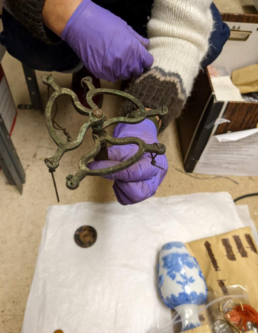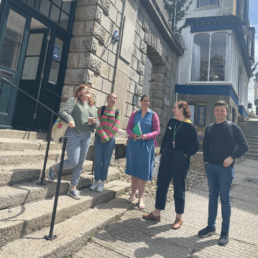LOFTY INTENTIONS: A STRATEGIC INVENTORY OF THE LOFT STORE
BY ISOBEL BLOOMFEILD AT THE MUSEUM OF CORNISH LIFE
The museum houses one of the largest social history collections in the South West, and ranges from archaeological evidence of the earliest settlers to the Lizard Peninsula, to a fully stocked 1950s kitchen.
The loft store (pictured) was a storage space that had, as far as records implied not been inventoried fully since its creation in 1999. It is a space that is packed with over 100 shelves, and numerous boxes, not to mention objects filling the aisles between shelving. It was a mammoth task, and one I knew would require the help of volunteers. It was clear that it might not be possible to finish it in the time I had left before my post ended…
CURATORIAL TASK: REFLECTIVE WRITING
Lofty Intentions: A Trainee Curator’s strategic inventory of the Loft Store
I began as Trainee Curator at Museum of Cornish Life in Helston in January 2022, and I have since had the opportunity to learn about the museum’s history, collection, and processes. Coming from a performance background, it is interesting that I relish the behind-the-scenes collections management work. After 6 months, I was really starting to want to do more collections work, and in discussions with the team it was decided that it would be useful if my project supported our ongoing process of understanding our collection and making sure our records are accurate. It is also in our current thinking to consider rationalising our collection and making moves to potentially remove some objects (deaccession in museum lingo), which do not fit our collections development policy.
Therefore, my inventory project was decided. The loft store (pictured) was a storage space that had, as far as records implied not been inventoried fully since its creation in 1999. It is a space that is packed with over 100 shelves, and numerous boxes, not to mention objects filling the aisles between shelving. It was a mammoth task, and one I knew would require the help of volunteers. It was clear that it might not be possible to finish it in the time I had left before my post ended. I am happy to say now, at the time of writing in January 2023, I am 3/4 of the way there, and although I am unlikely to finish completely, what is left is manageable for volunteers to continue.
I had done little inventorying before starting, but my aim was to be methodical in my approach. I started a colour coded spreadsheet for every shelf and area, and tracked my progress of completing actions to renumber, solve mysteries, relocate, or give attention/treatment to objects. I had originally planned to do an exhibition of some of the items I found, but I realised that in order to prioritise the progress I was making with the collection, it was not the best course of action. Although the inventory of a shelf is not particularly time-consuming, the actions required to then deal with issues arising takes time and effort.
Mystery objects with no, illegible, or wrong numbers were numerous in my inventorying process. Some were solved through searching registers, and some are still unsolved after scouring index cards and old documentation. After spending half a day or more weekly, for 4 months, myself and my volunteers have seen over a thousand objects, and it has been really useful, if a little overwhelming, to discover many items that have been located as unknown or presumed missing for years. The task is still in process, and I am writing this as I am trying to finish the inventories of the final numbered shelves, and to round off the actions which I can solve myself. This project has pushed me to sit with things instead of trying to solve queries instantly. Time has allowed me to figure out some mysteries which only appear obvious once another object on another shelf is found.
The problems occurring helped me realise what might support our collections management; we have therefore started number ordering and checking every index card (historic cards that describe and often depict objects), as these prove very useful when trying to work out if an unnumbered item matches one described on our digital collections database. Ultimately, I will be leaving my spreadsheet to be used and referred to by others, highlighting the priorities and actions that are still outstanding, and making sure the knowledge of the Loft Store collection is not lost on my departure.
As a final part of my project I conducted a talk on my discoveries at the museum on Tuesday 28th February 2023. It was great to share my experiences with an audience and be able to gain the input of those who attended to solve some more mysteries.
